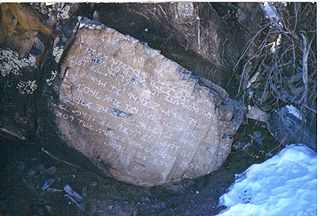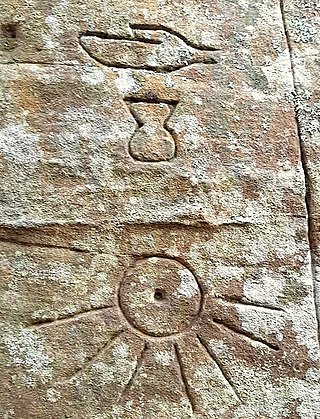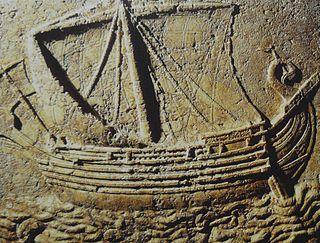Related Research Articles

An out-of-place artifact is an artifact of historical, archaeological, or paleontological interest to someone that is claimed to have been found in an unusual context, which someone claims to challenge conventional historical chronology by its presence in that context. Some people might think that those artifacts are too advanced for the technology known to have existed at the time, or that human presence existed at a time before humans are known to have existed. Other people might hypothesize about a contact between different cultures that is hard to account for with conventional historical understanding.

Iuka is a village in Marion County, Illinois, United States. The population was 512 at the 2020 census.
Pseudoarchaeology—also known as alternative archaeology, fringe archaeology, fantastic archaeology, cult archaeology, and spooky archaeology—is the interpretation of the past by people who are not professional archaeologists and who reject or ignore the accepted data gathering and analytical methods of the discipline. These pseudoscientific interpretations involve the use of artifacts, sites or materials to construct scientifically insubstantial theories to strengthen the pseudoarchaeologists' claims. Methods include exaggeration of evidence, dramatic or romanticized conclusions, use of fallacious arguments, and fabrication of evidence.
Fujimura Shinichi is a Japanese amateur archaeologist who claimed he had found a large number of stone artifacts dating back to the Lower Paleolithic and Middle Paleolithic periods. These objects were later revealed to be forgeries.

The Los Lunas Decalogue Stone is a hoax associated with a large boulder on the side of Hidden Mountain, near Los Lunas, New Mexico, about 35 miles (56 km) south of Albuquerque, that bears a nine-line inscription carved into a flat panel. The stone is also known as the Los Lunas Mystery Stone or Commandment Rock. The stone has gained notoriety in that some claim the inscription is Pre-Columbian, and therefore proof of early Semitic contact with the Americas. Standard archeological evidence contradicts this, however.

Francis Joseph Collin is an American former political activist and Midwest coordinator with the American Nazi Party, later known as the National Socialist White People's Party. After being ousted for being partly Jewish, in 1970, Collin founded the National Socialist Party of America. (N.S.P.A.) In the late 1970s, his planned march in the predominantly Jewish suburb of Skokie, Illinois was challenged; however, the American Civil Liberties Union defended Collin's group's freedom of speech and assembly in a case that reached the United States Supreme Court to correct procedural deficiencies. Specifically, the necessity of immediate appellate review of orders restraining the exercise of First Amendment rights was strongly emphasized in National Socialist Party v. Village of Skokie, 432 U.S. 43 (1977). Afterward, the Illinois Supreme Court held that the party had a right to march and to display swastikas, despite local opposition, based on the First Amendment to the United States Constitution. Collin then offered a compromise, offering to march in Chicago's Marquette Park instead of Skokie. After Collin was convicted and sentenced in 1979 for child molestation, he lost his position in the party.

The archaeology of Israel is the study of the archaeology of the present-day Israel, stretching from prehistory through three millennia of documented history. The ancient Land of Israel was a geographical bridge between the political and cultural centers of Mesopotamia and Egypt.

Archaeological forgery is the manufacture of supposedly ancient items that are sold to the antiquities market and may even end up in the collections of museums. It is related to art forgery.

The Michigan Relics are a series of alleged ancient artifacts that were "discovered" during the late nineteenth and early twentieth century. They were presented by some to be evidence that people of an ancient Near Eastern culture had lived in North America and the U.S. state of Michigan, which, is known as pre-Columbian contact. Many scholars have determined that the artifacts are archaeological forgeries. The Michigan Relics are considered to be one of the most elaborate and extensive pseudoarchaeological hoaxes ever perpetrated in American history.

The Ica stones are a collection of andesite stones from the Ica Province in Peru, known for their engraved motifs. Largely regarded to be modern hoaxes, the stones in some cases utilize art styles from various pre-Columbian Peruvian civilizations and often depict anachronistic scenes or objects, including dinosaurs and advanced technology.
Buhla is the name for a skeleton of a prehistoric (Paleo-Indian) woman found in a quarry near Buhl, Idaho, United States, in January 1989. The skeleton's age has been estimated by radiocarbon dating at 10,675 ± 95 BP, which confirms this as one of the oldest sets of human remains found in the Americas. The discovery was made by a quarry worker when he noticed what was found to be a thigh bone in the screen of a rock crusher. The nearly complete skeleton was subsequently unearthed nearby.
The Japanese Paleolithic hoax consisted of a number of lower and middle paleolithic finds in Japan discovered by amateur archaeologist Shinichi Fujimura, which were later all discovered to have been faked. The incident became one of the biggest scandals in archaeological circles in Japan after the story was published by the Mainichi Shimbun on November 5, 2000.

Karatepe is a late Hittite fortress and open-air museum in Osmaniye Province in southern Turkey lying at a distance of about 23 km from the district center of Kadirli. It is sited in the Taurus Mountains, on the right bank of the Ceyhan River. The site is contained within Karatepe-Aslantaş National Park.
The Bat Creek inscription is an inscribed stone tablet found by John W. Emmert on February 14, 1889. Emmert claimed to have found the tablet in Tipton Mound 3 during an excavation of Hopewell mounds in Loudon County, Tennessee. This excavation was part of a larger series of excavations that aimed to clarify the controversy regarding who is responsible for building the various mounds found in the Eastern United States.
The year 2010 in archaeology

The Castalian Springs Mound State Historic Site (40SU14) is a Mississippian culture archaeological site located near the small unincorporated community of Castalian Springs in Sumner County, Tennessee. The site was first excavated in the 1890s and again as recently as the 2005 to 2011 archaeological field school led by Dr. Kevin E. Smith. A number of important finds have been associated with the site, most particularly several examples of Mississippian stone statuary and the Castalian Springs shell gorget held by the National Museum of the American Indian. The site is owned by the State of Tennessee and is a State Historic Site managed by the Bledsoe's Lick Association for the Tennessee Historical Commission. The site is not currently open to the public.

The theory of Phoenician discovery of the Americas suggests that the earliest Old World contact with the Americas was not with Columbus or Norse settlers, but with the Phoenicians in the first millennium BC.

The archaeology of the Philippines is the study of past societies in the territory of the modern Republic of the Philippines, an island country in Southeast Asia, through material culture.
This page lists major events of 2019 in archaeology.
This page lists major events of 2021 in archaeology.
References
- ↑ Kleen, Michael (2010-01-01). Haunting the Prairie: A Tourists Guide to the Weird and Wild Places of Illinois. Black Oak Media. p. 131. ISBN 9780979040146 . Retrieved 2014-01-20– via Google Books.
- ↑ Troy Taylor; Mark Moran; Mark Sceurman (2005). Weird Illinois: Your Travel Guide to Illinois' Local Legends and Best Kept Secrets. Sterling Publishing Company. p. 38. ISBN 9780760759431 . Retrieved 2014-01-20– via Google Books.
- ↑ Feder, Kenneth L (2010). Encyclopedia of Dubious Archaeology: From Atlantis to the Walam Olum. ABC-CLIO. p. 49. ISBN 9780313379185 . Retrieved 2014-01-20– via Google Books.
- 1 2 3 Wilson, Joseph AP (2012). "The Cave Who Never Was: Outsider Archaeology and Failed Collaboration in the USA". Public Archaeology . 11 (2): 75–93. doi:10.1179/1465518712Z.0000000007. S2CID 162312493.
- ↑ Fell, H. B. (1987). Detecting Fraudulent Inscriptions. Epigraphic Society Occasional Publications, 16: 24.
- ↑ "True Suppressions 3: Burrows Cave, "Newark Holy Stones, "Sopher Plates"; Fakes as Orthodox Science Claims-Or - True Suppressions?". S8int.com. Retrieved 2014-01-21.
- ↑ "Ancient American Magazine - Book Store". Archived from the original on 2013-12-13. Retrieved 2014-01-21.
- ↑ Joseph, Frank (2009). Unearthing ancient America. New Page Books. ISBN 9781601630315 . Retrieved 20 January 2014.
- ↑ "America Unearthed: Grand Canyon Treasure Full Episode - America Unearthed". HISTORY.com. Retrieved 2014-01-21.
- ↑ "Review of America Unearthed S02E05: "Grand Canyon Treasure"". JasonColavito.com. 2013-12-29. Retrieved 2014-01-21.
- ↑ Rutland, Reece (Dec 21, 2013). "Marion County to appear in America Unearthed episode". Centralia Morning Sentinel.
- ↑ Meador, S. 2004. Untitled Review. "Rambles: A Cultural Arts Magazine", 3 January 2004